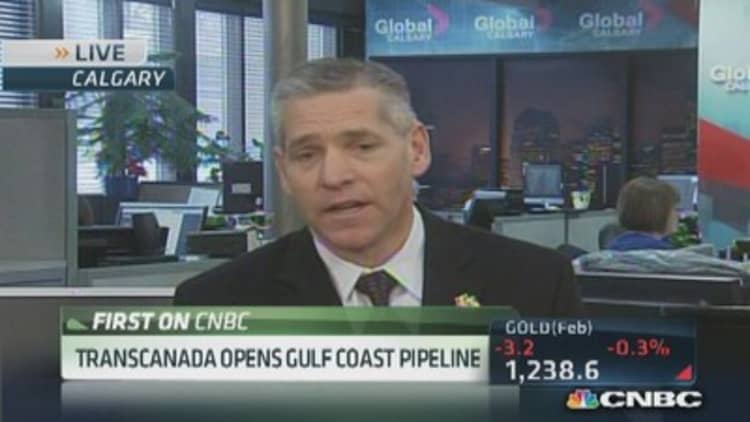
The southern leg of the Keystone XL pipeline started shipping oil on Wednesday, and that's good news for Valero and other oil refiners.
Keystone, operated by TransCanada, began transporting light, sweet crude from Cushing, Okla., to Port Arthur, Texas. Estimates suggest that when operating at full capacity, the 485-mile pipeline will be able to transport anywhere from 700,000 to 800,000 barrels of crude per day for refining.
The operation of the southern leg of Keystone represents a significant development within the energy industry, as it substantially increases Gulf Coast refinery access to midcontinent crude.
"The opening of the Keystone Pipeline south leg triples the amount of pipeline capacity from Cushing, Okla., to the Texas Gulf Coast," said Andy Lipow, president of Lipow Oil Associates. "The oil that arrives in the Port Arthur area will now be accessible to about 25 percent of the nation's refinery capacity because it will be connected by pipeline not only to Port Arthur but to Lake Charles and the New Orleans refining centers."
Aside from access, the pipeline also provides a cost advantage for refiners. According to Bill Day, a vice president at Valero, the pipeline will reduce the company's refining cost by roughly $15 per barrel.
"Valero is a refinery—we are in the business of processing oil and making it into products like gasoline and diesel. We buy oil, we don't drill for oil. We don't have our own supply, so we have to buy it in the market. The more oil that is available to refine for a low cost, the better we are and the better the refiners are," said Day.
The cost savings come partially from efficiency, but also because the refiners don't have to import more expensive, international crude.
(Read more: Energy industry voices decry move to export US oil)
"This crude gives you more choices, gives you more flexibility and it reduces costs when you have domestic oil coming down from Cushing and you don't have to compete with more expensive foreign oil that is coming in via ship," said Day.
That competitive advantage is key when it comes to the refinery business on the Gulf Coast, the location of one of the biggest concentrations of refining capacity in the world. The necessary infrastructure has already been built, so when additional capacity comes online, it's great for business.
The launch of the southern leg of the pipeline adds fuel to the fire for proponents of the northern leg of Keystone, a $5.4 billion project that could transport 830,000 barrels of heavy crude from Alberta, Canada, to the Gulf Coast along a nearly 1,200-mile route.
The Obama administration is still considering the project and maintains its position that it will not issue a final ruling until it knows more about the pipeline's potential environmental impact. Proponents of the project argue that the creation of tens of thousands of jobs and the efficiency of transporting crude simply cannot be ignored.
(Read more: )
In the meantime, the industry has been shipping oil from Canada and domestically via rail, but rail shipping costs more and can be dangerous; rail transport of oil is coming under scrutiny recently because of a string of accidents in the Bakken and Canada.
"Refiners would prefer to move crude via pipeline because it costs only $13 a barrel to go from parts of Canada to the Gulf Coast, if that same barrel of crude travels via rail the cost goes up to $17," said Lipow.
—By CNBC's Jackie DeAngelis. Follow her on Twitter @JackieDeAngelis


